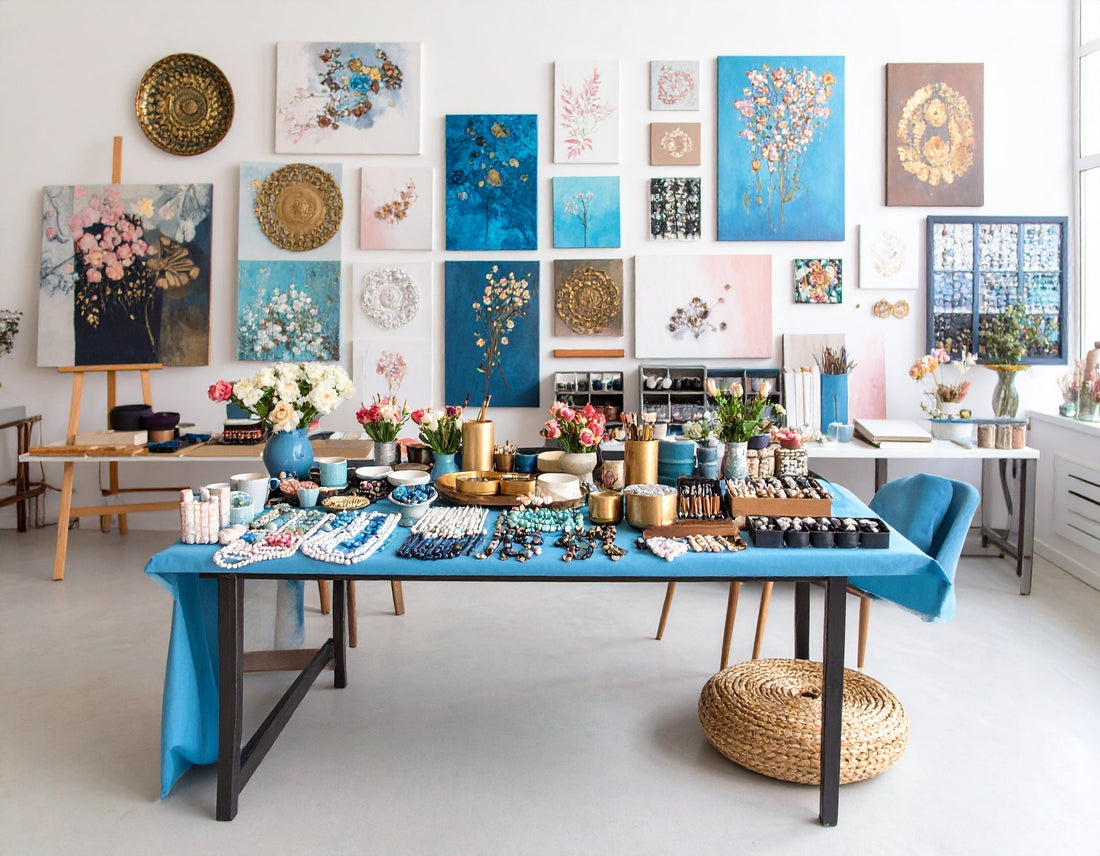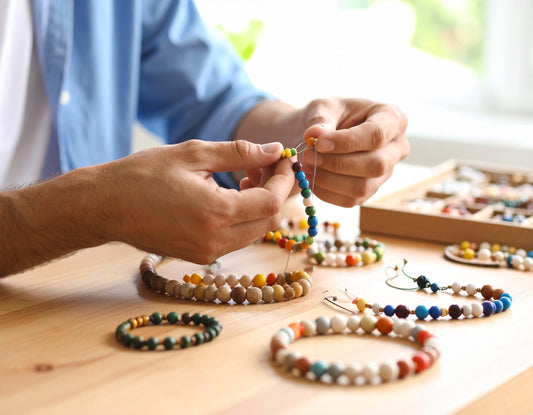
When the Ordinary Becomes Extraordinary: Transform Your Everyday Objects into Works of Art
Share
In a world where banality seems to predominate, it's time to reinvent the ordinary. Imagine for a moment that your everyday objects, those you brush past every day without paying attention, could become true works of art. Whether it's a mug refreshed with vibrant colors or an old chair transformed into the centerpiece of your home, each element harbors unsuspected creative potential. This article invites you to explore innovative and inspiring ways to transform your usual possessions into unique creations. Through practical tips and innovative ideas, discover how to breathe new life into your everyday surroundings. Prepare to transform your vision of decoration and reveal the artist within you. Embark with us on this captivating journey where the ordinary becomes the extraordinary!
The importance of creativity in daily life
Creativity is often perceived as a talent reserved for professional artists and designers. However, it plays a crucial role in everyone's daily life. Being creative isn't just about painting or sculpting; it's also about seeing the world from a new perspective, solving problems in innovative ways, and finding ways to beautify one's surroundings. Creativity allows us to express our individuality and connect more deeply with our personal space and with others. It also encourages mental flexibility, helping us navigate life's challenges with greater ease and optimism.

An artist's studio
By incorporating creativity into our daily routines, we can transform mundane tasks into rewarding experiences. For example, cooking can become a culinary art form, and gardening can be transformed into a botanical adventure. Every daily activity can be seen as an opportunity to innovate and explore new ideas. Furthermore, daily creativity can improve our overall well-being by reducing stress and increasing our personal satisfaction. By finding creative ways to solve problems or beautify our living space, we cultivate a positive and resilient attitude in the face of challenges.
Creativity in everyday life doesn't require grand projects or extensive resources. Sometimes, small gestures, like rearranging a shelf, painting an old piece of furniture, or personalizing a notebook, can have a significant impact. These creative acts remind us that we have the power to transform our environment and make it more personal and welcoming. By recognizing and valuing our capacity for innovation, we enrich our daily lives and open ourselves to new possibilities.
Everyday objects: a source of inspiration
Everyday objects are often seen as simple utilitarian tools, but they can become amazing sources of inspiration. Every item we use, from cups to chairs, from photo frames to old clothes, has hidden potential to become a unique work of art. By looking at these objects from a different perspective, we can discover unexpected creative possibilities. For example, an old ladder can be transformed into a rustic bookcase, or a simple glass bottle can become an elegant vase.

When O'Shiny Art & Lifestyle transforms everyday objects into works of art
By reusing and transforming everyday objects, we also contribute to sustainability and waste reduction. Rather than throwing away used items, we give them a new function and a new aesthetic. This eco-friendly approach not only protects the environment, but it also allows us to create unique pieces that tell our story and values. By rediscovering the creative potential of the objects around us, we can transform our home into a personal art gallery, full of character and charm.
Techniques for transforming your objects
There are a multitude of techniques for transforming everyday objects into works of art:
- Painting is one of the most accessible and versatile methods. With a few brushes and some paint cans, you can transform an old table into a colorful and modern piece. Painting techniques can range from simple color changes to more complex designs, such as stripes, stencils, or ombre effects. Chalk paint, for example, is ideal for giving a vintage look to antique furniture.
- Decoupage is another creative way to personalize your items. Using decorative paper, napkins, or even magazine pages, you can adhere designs to items such as boxes, vases, or trays. This technique allows you to create unique and detailed designs with minimal materials. Decoupage is particularly suitable for projects that require a precise and delicate finish, providing a sophisticated artistic touch.
- Creative recycling is also a popular technique for transforming objects. For example, wooden pallets can be converted into patio furniture, glass jars can become pendant lights, and used tires can be repurposed into planters. This approach encourages innovation and sustainability. By exploring various transformation techniques, you can discover new ways to beautify your space while expressing your personal creativity. Whether you're a novice or an expert, there's always a method that will suit your skills and artistic vision.

An example of materials for processing
Materials and tools needed for processing
To transform your everyday objects into works of art, it is essential to have the right materials and tools.
- Paint, as mentioned earlier, is a basic element. You'll need brushes of various sizes, rollers, and paint suitable for the surfaces you want to transform. Acrylic paints are versatile and dry quickly, while chalk paints are ideal for matte and vintage finishes. It can also be useful to have varnishes to seal and protect your creations.
- Decoupage tools are also essential for many projects. These include precision scissors, cutters, decoupage glue, and brushes for applying glue and smoothing surfaces. Decorative papers, paper napkins, and magazines can serve as base materials for this technique. Decoupage varnishes are also useful for sealing and protecting pasted designs, providing a durable and glossy finish.
- Creative upcycling projects may require a variety of tools and materials, depending on the object being repurposed. Saws, drills, screwdrivers, and paintbrushes can all play a role in creating new furniture or decorative items. Sandpaper is also useful for preparing surfaces before painting or gluing. Additionally, materials like wooden pallets, glass jars, fabrics, and ropes can be repurposed in innovative ways. Having a well-equipped and organized workspace will allow you to complete your upcycling projects efficiently and with pleasure.
Examples of successful transformation projects
Successful remodeling projects often combine creativity, functionality, and aesthetics. Take, for example, an old wooden chest of drawers. Rather than throwing it away, you can sand it, paint it with bright colors, and add new handles. The result is a piece of furniture that is not only functional but also becomes a centerpiece of your home, adding a touch of personality to your space.
Another inspiring example is transforming glass jars into pendant lights. With a little glass paint, electrical wire, bulbs, and sockets, these jars can be converted into beautiful lamps. By hanging these lights at different heights, you create unique and personalized lighting that brings a warm and artistic ambiance to your home. This project demonstrates how simple, everyday objects can be reimagined to serve a new decorative purpose.
Successful remodeling projects aren't limited to large pieces of furniture or lighting. Small items can also be successfully repurposed. For example, old picture frames can be repainted and decorated with decoupage designs to create unique wall art. Similarly, leftover fabric can be used to make decorative pillows or reupholster chairs, giving worn pieces a new life and a fresh look. By experimenting with different materials and techniques, you can discover innovative ways to transform everyday objects into artistic creations.
How to Integrate Art into Your Living Space
Incorporating art into your living space doesn't necessarily mean filling every corner with paintings and sculptures. Rather, it's about creating an environment that reflects your personality and creativity. Start by choosing pieces that resonate with you and complement your decorating style. Whether it's a revamped coffee table, a repurposed vase, or personalized throw pillows, each object should bring a touch of yourself to your home.
One of the easiest ways to incorporate art into your living space is to play with colors and textures. Paint an accent wall in a bold color, add textiles with interesting patterns, or mix different materials like wood, metal, and glass. These elements create visual focal points and add depth to your space. By incorporating repurposed objects, you can also create visual stories that captivate and inspire your guests.
Finally, don't be afraid to experiment with unconventional arrangements. Use floating shelves to display your artwork, create a gallery wall with frames of different sizes and shapes, or hang objects in unexpected ways. The goal is to create a space that is not only functional but also inspiring. By incorporating repurposed objects and playing with layout and presentation, you can create a unique interior that celebrates creativity and individuality.
The Impact of Art on Personal Well-Being
Art has a profound impact on our personal well-being. Creating and surrounding ourselves with works of art can strengthen our mental and emotional health. By engaging our creative minds, we can reduce stress and anxiety, promote relaxation, and improve our overall mood. The process of transforming everyday objects into works of art can be particularly therapeutic, offering an escape from daily concerns and a way to reconnect with ourselves.
Art also allows us to express emotions and thoughts that we can't always verbalize. By painting, sculpting, or transforming objects, we can externalize our feelings in a tangible way. This artistic expression can help clarify our emotions, resolve internal conflicts, and find a sense of peace. By integrating personal creations into our living space, we create an environment that nourishes us emotionally and reminds us of our ability to create beauty and meaning.
Furthermore, the connection between art and well-being isn't limited to personal creation. Appreciating and contemplating art in our daily surroundings can also have beneficial effects. Studies show that exposure to artwork can reduce stress, improve mood, and even boost creativity. By transforming your everyday objects into works of art, you create a space that is not only aesthetically pleasing but also beneficial for your personal well-being. It's an invitation to live more consciously and appreciate the little things that bring joy.
Sharing your creations: platforms and communities
Sharing your creations with others can be a source of great satisfaction and inspiration. There are many online platforms where you can showcase your work, get feedback, and connect with other creatives. Sites like Instagram, Pinterest, and Etsy are great for sharing photos of your projects and discovering new ideas. Create a dedicated account for your creations, use relevant hashtags, and engage with the community to increase your visibility and get constructive feedback.
Joining online communities can also provide valuable support and learning opportunities. Participate in forums, Facebook groups, or subreddits dedicated to repurposing and DIY projects. These communities are often full of enthusiasts willing to share their tips, experiences, and encouragement. By actively contributing, you can not only improve your skills but also inspire and be inspired by others.
Finally, don't forget about in-person sharing opportunities. Attend craft markets, local exhibitions, or community workshops to showcase your creations and meet other artists. These events can be enriching opportunities to showcase your work, get direct feedback, and build personal connections with like-minded people. By sharing your creations, you enrich not only your own experience but also that of your community, inspiring others to discover their own creative potential.
Conclusion and encouragement to creativity
Transforming everyday objects into works of art is a creative adventure that can enrich your life in many ways. It allows you to see the world in a new light, reinvent your surroundings, and discover hidden talents. By exploring different techniques, using a variety of materials, and sharing your creations, you can transform the mundane into beauty and the ordinary into the extraordinary. Each project is an opportunity to learn, grow, and express yourself in unique ways.
Don't be afraid to experiment and think outside the box. Creativity has no strict rules; it's guided by your imagination and passion. Whether you're a novice or an expert, every creative endeavor is a victory in itself. Take the time to savor the process, celebrate your successes, and learn from your mistakes. By fully embracing your creative potential, you can transform not only your everyday objects but also your perspective on life.
So, grab your brushes, scissors, tools, and imagination and start creating. The world is filled with endless possibilities, and every everyday object holds untold artistic potential. By transforming the ordinary into the extraordinary, you can create a space that's uniquely yours and inspires you. Unleash your creativity and discover the joy and satisfaction of seeing your ideas come to life. Embark on this exciting adventure and unleash your inner artist.



